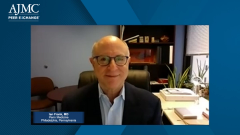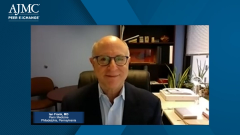
Grade A Recommendation: Impact of USPSTF Grading on PrEP
Experts in HIV provide insight into the Grade A recommendation for HIV PrEP by the U.S. Preventive Services Task Force (USPSTF) and its impact on patients, clinicians, and payers.
Episodes in this series

Neil Minkoff, MD: How has the Grade A [recommendation] for PrEP [pre-exposure prophylaxis] therapy from the U.S. Preventive Services Task Force [USPSTF] changed things, both on the provider’s side in terms of supporting the recommendations and that those recommendations will be followed, but also by payers? How has that change from the task force made a difference in identifying patients, treating patients, getting in front of patients, and so on? Or is it more something that we worry about in the background?
Carl Schmid, MBA: I think it’s one of the most significant things that has happened for PrEP. Once you have a Grade A from the U.S. Preventive Services Task Force, one, it’s a recommended preventive service that all providers should recommend to their patients. Then secondly, almost all plans have to provide that service without cost-sharing to the patient. That alleviates one of the past barriers to PrEP, and that’s the patient cost-sharing and deductibles. Now, that’s not an excuse anymore. Patients are clients. They don’t have to worry about that because it is now, thanks to the Affordable Care Act, covered as a preventive service without cost-sharing. This went into effect earlier this year. Thus, this is just taking off. We’re now making sure that the payers are complying with it. We did some analysis that some of them aren’t, or at least they’re not doing a good job of displaying their preventive services to their patient. You have to do a little looking and searching the formularies to make sure it’s covered. It really should be a seamless process. “This is your list of preventive services. They’re free to patients, and you should take advantage of it.” Also, we have an issue of what about the office visits? What about the laboratory services? What about ongoing tests? We are still waiting for some federal guidance to come out. But we want to make sure those are covered, just like colonoscopies, anesthesia, and the office visits, that they’re covered without cost-sharing as well. Thus, it’s not just the drug. It’s all the lab services. We have to educate providers, payers, and then patients so they know this is available. But this is a game-changer, and this should help alleviate some of the barriers to accessing PrEP.
Jeffrey Crowley, MPH: The point I’d make is it’s not just people advocating for everything under the sun. The…studies have proven the effectiveness of PrEP or the comprehensive PrEP regimen. They included the services Carl mentioned, but I’d also say that I agree with him. We do think this is going to be very significant. However, it’s too early to see in research that the USPSTF recommendation has changed things on the ground yet, but hopefully we’ll see that soon.
Neil Minkoff, MD: This is a question I was going to ask to the other 2 panelists, one of whom is doing the coverage issues and one of whom is doing the day-to-day management issues, is have you seen a difference in the way things are being addressed or engaged because of the change from the task force?
Ian Frank, MD: I haven’t seen any difference yet. I think anything that can help overcome some of the financial obstacles is a major advance. However, again, I’m practicing in an area where there hasn’t been that much in the way of financial obstacles, fortunately. Thus, I think in my immediate area, this isn’t going to be much of a change. The more important thing is the need for more awareness. I think that’s a greater obstacle. Even if somebody was uninsured and there was no mechanism to provide PrEP, at least the drug costs, the drug would be provided by the manufacturer for free. Doing the necessary laboratory monitoring would be a cost they don’t cover, and subsequently, that becomes the obstacle. However, at least you’re part way there. I think when the CDC [Centers for Disease Control and Prevention] comes up with recommendations, or preventive task forces come up with recommendations, those endorsements are powerful. However, it’s usually not the trigger that leads to the implementation of a practice, at least in my experience. I think in a way those recommendations are following the practice, they’re not the thing that initiates the practice.
Neil Minkoff, MD: Would you say that also applies to the International Antiviral Society [IAS], the IAS-USA guidelines, and how those have changed? Do you feel those are also following behind?
Ian Frank, MD: I think those guidelines follow the data. The data are generated; practitioners are starting to modify the practice. The medical guidelines are endorsing that change in practice. Then, I think other governmental or public health organizations recognize the impact of the practice, and they further endorse what has already begun. Thus, I don’t want to diminish the importance of the recommendation from a public health perspective. However, from an individual provider’s practice, I wonder how impactful these kinds of recommendations are. For some, yes. For others, I think it has less of an impact.
Neil Minkoff, MD: You’ve mentioned a couple times about being at an academic medical center in the Northeast with more infrastructure around you. Do you think these guideline changes, whether it’s the USPSTF or the IAS guidelines, are affecting practices or practice behavior in other parts of the US that might not be in the kind of environment you’re in?
Ian Frank, MD: I hope so. I hope people are practicing in systems where providers are encouraged by the use of electronic medical record systems or other practice guideline groups that institute, or try to oversee quality care, at an institutional or practice level. I hope they keep track of recommendations like this, and this one in particular, and are encouraging their providers to do it. I don’t know how often people get tested for HIV around the country. That’s a simpler, also endorsed, recommendation. Thus, when I’m rounding with our team on the inpatient side of things, I’m always encouraging them to find out if this hospitalized patient has ever been tested for HIV, and it is not always the case. I think we need to be vigilant in keeping these recommendations in our minds and discussing them. However, just having the recommendation isn’t enough. You need something more.
Ryan Bitton, PharmD, MBA: I’ll jump in from a payer perspective. I think the reaction is pretty set in stone. When the task force recommends something on a grade level, we’ve got our marching orders on what actually happens. We’ve got preventive service guidelines for all sorts of disease states that have preventive recommendations. There’s no co-pay; you get first dollar coverage. You don’t have to worry about deductibles and complicated things like that from a benefit design perspective. That’s what happens when the task force recommends something from a payer perspective. I will say the IAS guidelines don’t really give us any to-do items. Obviously, those are part of our clinical reviews within a health plan space, but it’s really the task force that kicks off that new design and benefits that are associated with their recommendations.
Jeffrey Crowley, MPH: I wanted to jump in with an observation. The way I look at it is as a step back. I think the CDC’s guidelines, yes, are evidence-based, but often they’re more aspirational. They’re like, “What does the field think we should be doing?” When there’s evidence, great, but even if there’s no evidence, they point the way. I think the U.S. Preventive Services Task Force is saying there’s a weight of evidence to justify making certain things happen. When Dr. Frank says we need something in the middle in the IAS-USA guidelines, it’s just because payment is available for PrEP doesn’t mean anybody will get PrEP. Thus, it’s really what’s in the middle to ensure that prescribers are prescribing PrEP when it’s needed. That’s where the IAS-USA guidelines come into play, but they’re not a hammer. They’re just a suggestion in some way. How do we give those or other forms of guidelines greater weight so they’re actually adopted and used?
Transcript edited for clarity.
Newsletter
Stay ahead of policy, cost, and value—subscribe to AJMC for expert insights at the intersection of clinical care and health economics.









































